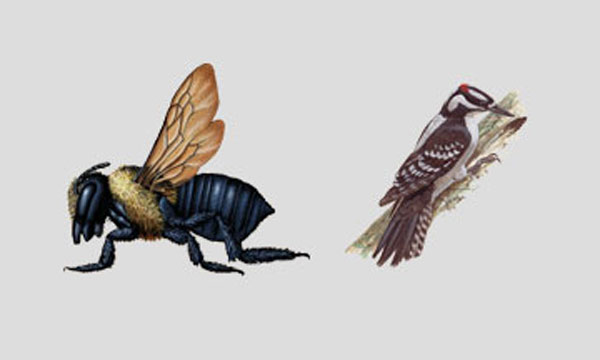The Woodpecker-Carpenter Bee Connection
By Chris Williams on May 14, 2013.

Question
For the last couple of days, we have been battling with woodpeckers that are banging on our gutters around the roofline. They’re pecking at the fascia boards and really tearing them up and also making a racket pecking on the aluminum gutters. Why are they doing this and how can we make them stop? We scare them away but they come right back.
Answer
Woodpeckers can be a real problem when they start this kind of behavior. They peck on buildings for various reasons–to enlarge a hole for a nest site, or to attract a mate by “drumming.” But, because of the time of year and because of the location of the damage, I suspect that your woodpeckers are trying to reach carpenter bee larvae that are inside the fascia boards or soffits on your house.
Woodpeckers feed on insects, mostly wood-boring insect larvae that they peck out of trees or fence posts, cedar siding, or other sites. Carpenter bee larvae don’t feed on wood but they do develop inside tunnels in wood created by the female bee. In spring, the large black and yellow bee excavates a dime-sized, circular hole, usually in weathered, unpainted wood. Soffits and fascia boards are a common nest site because they are rarely painted on the backside. Carpenter bees will chew an entrance hole on the face of the board, then turn the tunnel at a right angle to follow the length of the board.
If you think about it, you will probably remember seeing carpenter bees buzzing about your house in the same area. The male bee aggressively guards the nest, but he can’t sting. The female is busy creating a nest tunnel and provisioning it with balls of pollen for her larvae to feed on. As the larvae fatten and move around inside their tunnel, they are detected by woodpeckers who try to get at them by pecking into the tunnel.
Woodpeckers are protected by law, so control is limited to repellents or exclusion. Visual repellents like mylar balloons or tape sometimes work, or netting, sheeting, or metal sheathing can be installed to protect the area. But if the woodpeckers are after food in the form of carpenter bee larvae, they will be difficult to discourage. The best control in this case is to treat the carpenter bee nests to kill the larvae inside. While woodpeckers may continue to work the bee nest for awhile afterwards, they will eventually stop once they can no longer detect the movement of the larvae inside the wood.
Give us a call. We can take care of the carpenter bees for you and can advise you on how to prevent carpenter bee nesting in the future. In the meantime, our technicians will take steps to keep the woodpeckers from causing any further damage to your home.